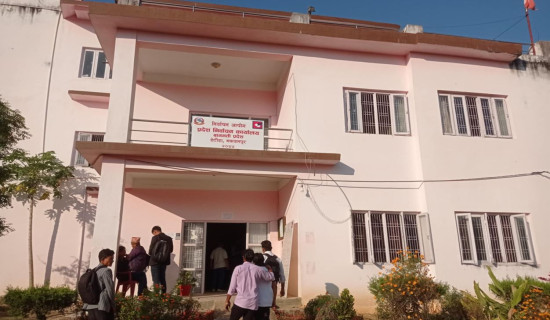- Monday, 1 December 2025
Birds begin migrating to Tarai from mountains
By Baburam Karki,Barahachhetra, Oct. 14: The arrival of migratory water birds from within the country and abroad has begun across the Tarai region, stretching from eastern to western Nepal.
The number of migrating birds has been increasing since the first week of October. With the start of migration, various species of guest birds have been seen in the Tarai.
According to ornithologist Anish Timilsina, species such as the Karyangkurung (Common Crane), Jalewa (Great Cormorant), Khoya Hans (Bar-headed Goose) and Sindure Hans (Eurasian Wigeon) and other migratory birds have started arriving at rivers and lakes across the Tarai region of eastern and western Nepal.
He said that the migration of birds such as the Sindure Hans (Eurasian Wigeon), Alchandra Rajputrika (Gadwall), Northern Shoveler (Banasu Sudiya), Common Pochard (Kale tauke hans), Ferruginous Duck (Baikal gauri) and other large waterbirds has begun.
According to ornithologist Timilsina, birds like the Greylag Goose (Kal hans), Great Crested Grebe (Siuere dubulki chara), Greater White-fronted Goose (Sweta macha kalhans), White-breasted Waterhen (Dwashe sim khukura), Brown Crake, Bittern, Night Heron and Tufted Duck have also started to appear.
Migratory birds have begun appearing in the grasslands, forests and border areas of Sunsari, Morang, Jhapa, Saptari, Udayapur and Siraha districts, having arrived from the hills and Himalayas.
According to Timilsina, the Bar-headed Goose, which can fly up to 9,000 metres, has started to visit the wetlands and border areas of the Tarai to escape the cold.
Every year, as temperatures drop in the Himalayan regions, so birds migrate internally to the warmer Tarai plains. It has been reported that birds have already started arriving at the Koshi Tappu Wildlife Reserve and nearby areas in eastern Nepal.
Ornithologist Timilsina said that birds migrate to the Tarai in winter because they cannot tolerate extreme cold, and return to their permanent habitats during summer. Birds living at altitudes between 2,000 and 3,000 metres in eastern part of the country also migrate to the Tarai during winter to avoid the chill.
Species such as Common Rosefinch, Warbler, thrushes and flycatchers from the Himalayan and hilly regions have been spotted in and around the Koshi Tappu Wildlife Reserve.
The migratory birds that come to the Tarai depend mainly on wetlands and grasslands. Goose and other species arrive via Koshi Tappu and spread across rivers, streams, and lakes throughout the Tarai.
Nature guide Bimal Timilsina said that migratory birds come from countries such as Siberia, Myanmar, China, Mongolia, Russia, Korea and Thailand to escape the harsh winter. He added that these birds can now be easily seen in and around the lakes of the Koshi area.
The birds that migrate from the hills and mountains to the wetlands, grasslands, ponds and lakes of the Tarai usually return by the end of March. Each year, most of the migratory species arrive in the Tarai by mid-January, with the highest number recorded at the Koshi Tappu Wildlife Reserve.
Winter migratory birds spend cold months in wetland areas such as the Koshi Tappu Wildlife Reserve, Chitwan National Park, Shuklaphanta National Park, Bishazari Lake, Jagadishpur Lake, Ghodaghodi Lake and the Koshi, Gandaki, and Narayani rivers and their tributaries.
Their migration continues throughout the year in search of favourable weather, safe habitats and food.















